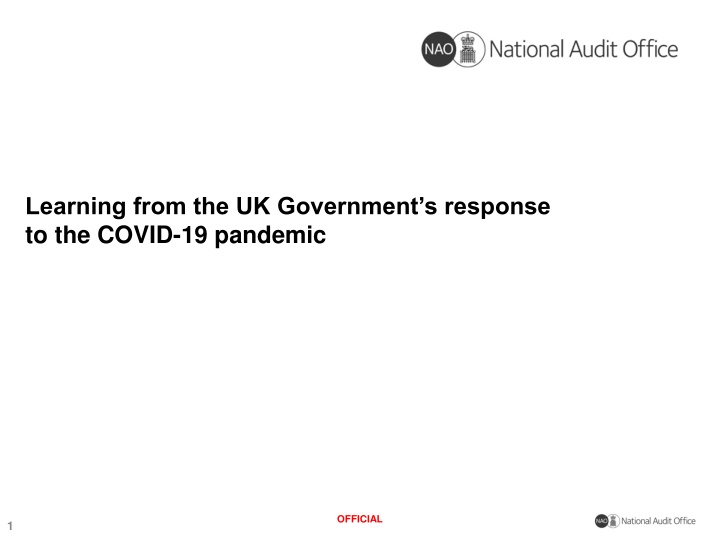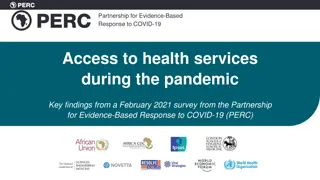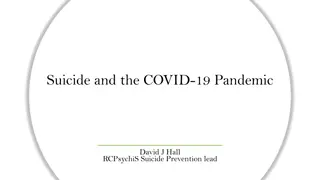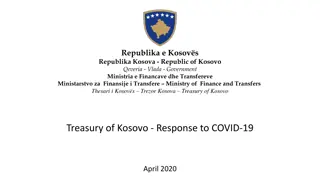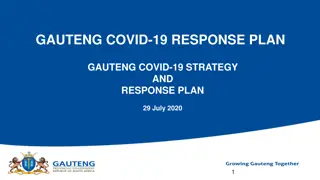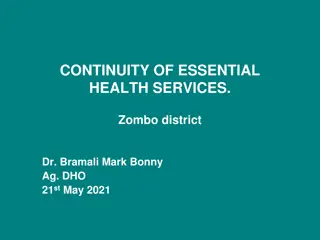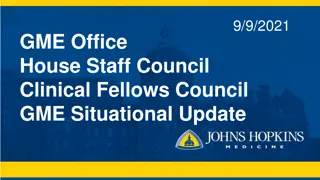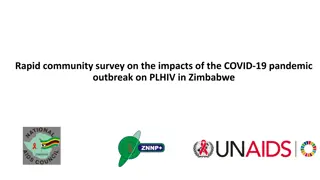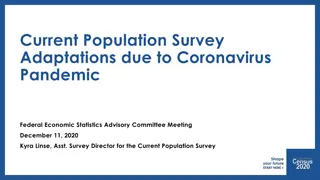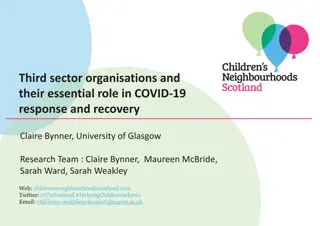Learning from the UK Government’s response to the COVID-19 Pandemic
Published reports analyze UK government's response to COVID-19, highlighting successes, failures, and areas for improvement. Insights cover accountability, transparency, risk management, data quality, coordination, and support for frontline workers.
Download Presentation

Please find below an Image/Link to download the presentation.
The content on the website is provided AS IS for your information and personal use only. It may not be sold, licensed, or shared on other websites without obtaining consent from the author.If you encounter any issues during the download, it is possible that the publisher has removed the file from their server.
You are allowed to download the files provided on this website for personal or commercial use, subject to the condition that they are used lawfully. All files are the property of their respective owners.
The content on the website is provided AS IS for your information and personal use only. It may not be sold, licensed, or shared on other websites without obtaining consent from the author.
E N D
Presentation Transcript
Learning from the UK Governments response to the COVID-19 pandemic OFFICIAL 1
Background Published over 30 reports on various aspects of the government s response to the pandemic we have used a variety of mechanisms to enhance accountability and transparency This presentation brings together our initial thoughts on learning from this body of work The pandemic has provided new learning on what has worked well and what hasn t but has also laid bare existing fault lines within society, public services and government itself OFFICIAL 2
Our publications We have published over 30 reports on COVID-19 on a range of topics 3 PROTECT - AUDIT
Covid tracker COVID-19 cost tracker - National Audit Office (NAO) 4 PROTECT - AUDIT
Emerging themes from our COVID-19 reports Identifying the wide-ranging consequences of major emergencies and developing playbooks for the most significant impacts. Being clear about risk appetite and risk tolerance as the basis for choosing which trade-offs should be made in emergencies. Risk management Being clear and transparent about what government is trying to achieve, so that it can assesses whether it is making a difference. Meeting transparency requirements and providing clear documentation to support decision-making, with transparency being used as a control when other measures, such as competition, are not in place. Producing clear and timely communications. Transparency and public trust Improving the accuracy, completeness and interoperability of key datasets and sharing them promptly across delivery chains. Monitoring how programmes are operating, forecasting changes in demand as far as possible, and tackling issues arising from rapid implementation or changes in demand. Gathering information from end-users and front-line staff more systematically to test the effectiveness of programmes and undertake corrective action when required. Data and evidence Ensuring that there is effective coordination and communication between government departments, central and local government, and private and public sector bodies. Clarifying responsibilities for decision- making, implementation and governance, especially where delivery chains are complex and involve multiple actors. Integrating health and social care and placing social care on an equal footing with the NHS. Balancing the relative merits of central, universal offers of support against targeted local support. Coordination and delivery models Understanding to what extent the pandemic and government's response have widened inequalities, and taking action where they have. Providing appropriate support to front-line and other key workers to cope with the physical, mental and emotional demands of responding to the pandemic. Supporting and protecting people Placing the NHS and local government on a sustainable footing, to improve their ability to respond to future emergencies. Ensuring that existing systems can respond effectively and flexibly to emergencies, including provision for spare or additional capacity and redeploying staff where needed. Considering which COVID-19-related spending commitments are likely to be retained for the long term, and what these additional spending commitments mean for long-term financial sustainability. Workforce and capacity 5 OFFICIAL
Theme 1: Risk management Supporting findings from our work Government lacked a playbook for many aspects of its response Learning Identifying the wide-ranging consequences of major emergencies and developing playbooks for the most significant impacts. Once the scale of the COVID-19 outbreak in the UK became apparent, the government made a number of rapid, large-scale spending decisions To enable speed of action, government relaxed controls and streamlined spending approvals, leading to an increased risk of fraud and error Being clear about risk appetite and risk tolerance as the basis for choosing which trade-offs should be made in emergencies. Government accepted other trade-offs from acting quickly, such as paying higher prices for goods than it would have paid before the pandemic 19 ministerial directions were issued in 2020 Government focused on getting some programmes up and running quickly, recognising that they may need to be amended as they went. Somedepartments made good use of ministerial directions to proceed with programmes where they lacked assurance over value for money. Due to the speed at which programmes were being implemented, accounting officers could not gain assurance over the value for money of several COVID- 19 response measures. Six directions were issued in 2019 (four on VFM grounds). Source: catalogue of ministerial directions on GOV.UK OFFICIAL 6
Theme 2: Transparency and public trust Supporting findings from our work Learning Detailed objectives help to ensure that the success of programmes can be measured. Transparency, including a clear audit trail to support key decisions, is a vital control to ensure accountability when government is having to act at pace with fewer controls or emergency procedures in place Being clear and transparent about what government is trying to achieve, so that it can assess whether it is making a difference. Meeting transparency requirements and providing clear documentation to support decision-making, with transparency being used as a control when other measures, such as competition, are not in place. We found that many of the contracts awarded during the pandemic had not been published on time (see box) Effective communication and public engagement is crucial to ensuring that key COVID-19 response programmes succeed Communications from government were not always timely, clear and consistent Producing clear and timely communications. Contract awards during the pandemic Of the 1,644 contracts awarded across government up to the end of July 2020 with a contract value above 25,000: 25% were published within the 90-day target; and 55% had not had their details published by 10 November 2020. Source: NAO, Investigation into government procurement during the COVID-19 pandemic OFFICIAL 7
Theme 3: Data and evidence Learning Supporting findings from our work Timely sharing and exchange of data is vital for providing front-line services and managing the response at the national level Improving the accuracy, completeness and interoperability of key datasets and sharing them promptly across delivery chains. However, timely sharing of data has not always occurred, and legacy IT issues remain challenging Monitoring how programmes are operating, forecasting changes in demand as far as possible, and tackling issues arising from rapid implementation or changes in demand. Limitations in the accuracy and completeness of the data used and collected by government have affected several pandemic response schemes Government has been able to take remedial action to address some issues arising from rapid implementation, and improve performance Gathering information from end- users and front-line staff more systematically to test the effectiveness of programmes and undertake corrective action when required. Data limitations affected the government s ability to assess the effectiveness and value for money of some measures, which made it harder to adapt its response and manage the risks of rapid implementation: Government s ability to forecast changes in demand, and to update programmes based on updated demand, has been variable. Gathering feedback from end users (including frontline staff) is essential to monitoring the effectiveness of interventions and improve existing processes. Detailed data for NHS Test and Trace supported tracking of performance Performance from 28 May to 4 November 2020 Source: NAO analysis of ONS, NHST&T and GOV.UK COVID dashboard data OFFICIAL 8
Theme 4: Coordination and delivery models Supporting findings from our work The pandemic response involved examples of effective cross-government and public-private sector collaboration. Learning Ensuring that there is effective coordination and communication between government departments, central and local government, and private and public sector bodies. Effective governance, lines of accountability, and resourcing responsibilities are important for an effective rapid response in an emergency situation Government has modified the governance arrangements of key pandemic response programmes Clarifying responsibilities for decision- making, implementation and governance, especially where delivery chains are complex and involve multiple actors. Issues predating the pandemic made responding to the crisis more difficult in some areas. Pandemic response measures have employed a combination of universal offers and targeted delivery models. Universal offers of support can be developed at speed but may not always be as cost-effective as targeted offers. Integrating health and social care and placing social care on an equal footing with the NHS. Balancing the relative merits of central, universal offers of support against targeted local support. OFFICIAL 9
Theme 5: Supporting and protecting people Supporting findings from our work The pandemic has disproportionately impacted specific groups of people Learning Understanding to what extent the pandemic and government's response have widened inequalities, and taking action where they have. Employment support programmes helped many people, but some people were not eligible Some Departments are undertaking further work to better understand take up of support schemes by different groups Providing appropriate support to front-line and other key workers to cope with the physical, mental and emotional demands of responding to the pandemic. The pandemic placed great stress on some health and social care workers already under pressure before the COVID-19 outbreak People supported and ineligible for employment support schemes up to 20 Sept 2020 Coronavirus Job Retention Scheme 9.6m 1.1m Self-Employment Income Support Scheme 2.6m 1.8m People supported People ineligible Source: NAO, Implementing employment support schemes in response to the COVID-19 pandemic OFFICIAL 10
Theme 6: Workforce and capacity Learning Supporting findings from our work The NHS and local government now face two main challenges: to maintain readiness to respond to emergencies, such as COVID-19, and to put other essential services onto a sustainable footing Placing the NHS and local government on a sustainable footing, to improve their ability to respond to future emergencies. Local authorities finances have been scarred and will not bounce back quickly once the pandemic ends. Existing workforce issues added to the challenges in responding to the pandemic. Government took action to increase the workforce available and was able to redeploy staff in key areas Ensuring that existing systems can respond effectively and flexibly to emergencies, including provision for spare or additional capacity and redeploying staff where needed. Our good practice guide Improving operational delivery in government notes that government s operational management capability has changed little over the past 10 years Considering which COVID-19-related spending commitments are likely to be retained for the long term, and what these additional spending commitments mean for long-term financial sustainability. By the end of July 2021, the government had committed an estimated 370 billion to its response to the pandemic Additional staff deployed to support the NHS in England as at 30 April 2020 Source: NAO, Readying the NHS and adult social care in England for COVID-19 OFFICIAL 11
Concluding remarks The challenges posed by the pandemic have highlighted: The importance for government of adopting a systematic approach to preparing for high-impact events, evaluating its performance frequently, and acting quickly on learning points while adhering to required standards of transparency and accountability even in emergencies. This goes beyond meeting legal (or audit) requirements. It involves adhering to the standards that government has set for itself to maintain and strengthen public trust. If government can build resilience into systems and delivery chains, and develop consistently robust horizon scanning, risk management and operational management capabilities across government, this will help it to cope better with future emergency responses while also improving business-as-usual activities. The pandemic has also laid bare existing fault lines: For example, the relationship between adult social care and the NHS, workforce shortages, the challenges posed by legacy data and IT systems, and the financial pressure felt by parts of the system all require long-term solutions. OFFICIAL 12
